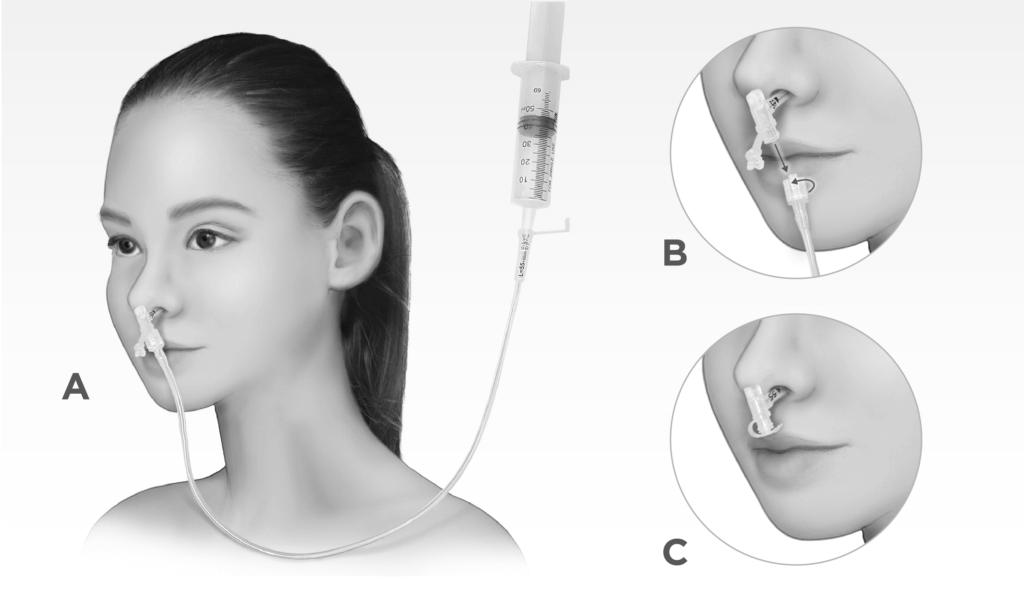
Nasogastric (NG) Tube Feeding
A medical procedure in which a tube is inserted through the nose, past the throat, and down into the stomach to provide nutrition to individuals who cannot eat by mouth. This procedure is commonly used in various medical conditions that impede the normal intake of food and fluids, ensuring that patients receive the necessary nutrients to maintain their health and support recovery.
NG tube feeding is an essential component of medical care for patients with severe dysphagia, certain neurological conditions, head and neck cancers, and other situations where oral intake is compromised. This blog will provide an in-depth look at NG tube feeding, including types of tubes, indications, commonly used formulas, administration methods, precautionary measures, and home-prepared feeding options.
Types of Feeding Tubes
Nasogastric (NG) Tubes
NG tubes are flexible tubes inserted through the nostril, passing through the esophagus, and into the stomach. These tubes are used for short-term feeding, typically less than four to six weeks. NG tubes come in various sizes and materials, such as silicone or polyurethane. Common types include the Salem Sump tube, which has a double lumen for simultaneous feeding and suction, and the Levin tube, which is a single-lumen tube used primarily for feeding.
Nasoduodenal (ND) and Nasojejunal (NJ) Tubes
ND and NJ tubes are similar to NG tubes but extend further into the small intestine. ND tubes end in the duodenum, while NJ tubes reach the jejunum. These tubes are used when feeding into the stomach is not possible or advisable, such as in cases of severe reflux, gastroparesis, or high aspiration risk. Placement of ND and NJ tubes typically requires fluoroscopic or endoscopic guidance to ensure correct positioning.
Percutaneous Endoscopic Gastrostomy (PEG) Tubes
PEG tubes are placed directly into the stomach through the abdominal wall using an endoscopic procedure. This method is suitable for long-term feeding, often used when a patient requires nutritional support for more than four to six weeks. PEG tubes are considered more comfortable and less prone to dislodgement compared to NG tubes, making them a preferred option for long-term care.
Causes for Starting NG Feed
Several medical conditions and circumstances necessitate the initiation of NG feeding, including:
- Neurological Disorders: Conditions such as stroke, amyotrophic lateral sclerosis (ALS), and multiple sclerosis can impair swallowing, making NG feeding necessary to prevent aspiration and ensure adequate nutrition.
- Head and Neck Cancer: Tumors, radiation, and surgery in the head and neck region can interfere with normal eating, requiring NG feeding for nutritional support during treatment and recovery.
- Severe Dysphagia: Swallowing difficulties due to various causes, such as esophageal strictures or neurological impairments, may necessitate NG feeding.
- Critical Illness: Patients in intensive care units (ICUs) who are unable to eat due to sedation, mechanical ventilation, or severe illness may receive NG feeding.
- Gastrointestinal Surgery: Postoperative patients who cannot resume oral intake immediately may require NG feeding to meet their nutritional needs during recovery.
- Malnutrition and Cachexia: Individuals with severe malnutrition or cachexia due to chronic illnesses like cancer or HIV/AIDS may benefit from NG feeding to improve their nutritional status.
Typical NG Feeding Formulas in the United States
In the United States, a variety of commercial NG feeding formulas are available to meet the diverse nutritional needs of patients. These formulas are designed to provide balanced nutrition, including carbohydrates, proteins, fats, vitamins, and minerals. Commonly used formulas include:
- Standard Formulas: These are complete, balanced formulas suitable for most patients. Examples include Ensure, Jevity, and Osmolite.
- High-Calorie Formulas: These formulas provide increased caloric density for patients with higher energy needs or fluid restrictions. Examples include TwoCal HN and Nutren 2.0.
- High-Protein Formulas: Designed for patients requiring additional protein, such as those with wounds or pressure ulcers. Examples include Promote and Impact Peptide.
- Elemental Formulas: These formulas contain partially or fully hydrolyzed nutrients, making them easier to digest for patients with malabsorption issues. Examples include Peptamen and Vivonex.
- Disease-Specific Formulas: Tailored for patients with specific medical conditions, such as diabetes or renal disease. Examples include Glucerna for diabetes and Nepro for renal disease.
NG Feeding Products that are Available in Market
- Ensure: A standard formula providing balanced nutrition, including proteins, carbohydrates, fats, vitamins, and minerals. It is commonly used for patients with normal digestive and absorptive functions.
- Jevity: A fiber-fortified formula that supports digestive health and is suitable for long-term feeding. It includes a blend of soluble and insoluble fibers to promote bowel regularity.
- Osmolite: A calorie-dense, low-residue formula designed for patients with limited fluid tolerance or increased energy needs. It is often used in patients requiring fluid restriction.
- TwoCal HN: A high-calorie, high-nitrogen formula providing 2 calories per milliliter. It is suitable for patients with elevated caloric and protein needs or those with fluid restrictions.
- Nutren 2.0: Another high-calorie formula providing 2 calories per milliliter, suitable for patients with increased energy needs or fluid restrictions.
- Promote: A high-protein formula designed to support wound healing and muscle maintenance. It is ideal for patients with increased protein requirements.
- Impact Peptide: A peptide-based formula that supports immune function and is easily digestible. It is often used for patients with malabsorption or those in critical care.
- Peptamen: An elemental formula containing hydrolyzed proteins and medium-chain triglycerides (MCTs) for easier digestion and absorption. It is suitable for patients with gastrointestinal disorders.
- Vivonex: A completely elemental formula providing amino acids, carbohydrates, and fats in their simplest forms. It is used for patients with severe malabsorption.
- Glucerna: A diabetes-specific formula with a low glycemic index, designed to help manage blood sugar levels. It includes a blend of carbohydrates that release slowly.
- Nepro: A renal-specific formula providing controlled levels of protein, potassium, phosphorus, and sodium. It is designed for patients with chronic kidney disease on dialysis.
How to Administer NG Feed
Administering NG feed involves several steps to ensure proper delivery and patient safety:
- Preparation:
- Verify the physician’s order for the type and amount of formula.
- Wash hands thoroughly and wear gloves to maintain hygiene.
- Gather all necessary supplies, including the NG tube, feeding formula, syringe, and water for flushing.
- Tube Placement:
- Confirm the correct placement of the NG tube by checking the tube markings, auscultating for air, or using pH testing of gastric aspirate.
- Secure the tube to the patient's nose and clothing to prevent dislodgement.
- Feeding:
- Check for residual stomach contents by aspirating with a syringe. If the residual is high, consult a healthcare professional before proceeding.
- Warm the feeding formula to room temperature to prevent discomfort.
- Attach the feeding syringe to the NG tube and pour the formula into the syringe, allowing gravity to assist the flow. Alternatively, use a feeding pump for continuous or controlled-rate feeding.
- Flush the tube with water before and after feeding to maintain patency and prevent clogging.
- Monitoring:
- Observe the patient for any signs of discomfort, aspiration, or intolerance during and after feeding.
- Document the amount of formula administered, residuals checked, and any observations related to the feeding process.
Precautionary Measures
To ensure the safety and effectiveness of NG feeding, several precautionary measures should be taken:
- Tube Placement Verification: Always verify the correct placement of the NG tube before each feeding to prevent complications such as aspiration or tube misplacement.
- Hygiene: Maintain strict hygiene during the feeding process to prevent infections. Wash hands, use gloves, and keep the feeding equipment clean.
- Patient Positioning: Position the patient in an upright or semi-upright position (at least 30-45 degrees) during feeding and for 30-60 minutes afterward to reduce the risk of aspiration.
- Monitoring: Regularly monitor the patient for signs of intolerance, such as nausea, vomiting, diarrhea, or abdominal distension. Report any concerns to a healthcare professional.
- Tube Care: Flush the NG tube with water before and after each feeding to prevent clogging. If a clog occurs, try flushing with warm water or a designated tube unclogging solution.
- Hydration: Ensure the patient receives adequate hydration, as feeding formulas may not provide sufficient fluids. Consult a healthcare professional for appropriate fluid recommendations.
Home-Prepared Feeding Products
In some cases, homemade feeding formulas can be used as an alternative to commercial products. These home-prepared feeds should be nutritionally balanced and easy to administer through an NG tube. Here are a few examples:
- Blenderized Diets: These are homemade blends of whole foods, designed to provide complete nutrition. Ingredients may include cooked vegetables, fruits, grains, meats, dairy, and oils, blended to a smooth consistency. It is important to ensure that the mixture is thin enough to pass through the NG tube without clogging.
- Soup-Based Formulas: Nutrient-dense soups made from a combination of vegetables, legumes, meats, and grains can be blended and strained to create a smooth, liquid feed. Adding broth or water can help achieve the desired consistency.
- Smoothies: Nutrient-rich smoothies made with fruits, vegetables, yogurt, protein powder, and healthy fats can serve as a nutritious option for NG feeding. Ensure the smoothie is well-blended and strained if necessary.
- Homemade Supplements: Simple supplements like milk, yogurt, and protein shakes can be used to provide additional nutrition. These can be fortified with vitamins and minerals to meet the patient's specific needs.
When using home-prepared feeding formulas, it is crucial to consult with a healthcare professional or dietitian to ensure nutritional adequacy and safety.
Conclusion
NG tube feeding is a vital medical intervention for patients unable to consume food orally due to various medical conditions. Understanding the different types of feeding tubes, indications for use, commonly available formulas, and proper administration techniques is essential for providing effective nutritional support. By adhering to precautionary measures and considering home-prepared feeding options, healthcare providers and caregivers can ensure the safety, comfort, and well-being of patients receiving NG tube feeding. With proper care and attention, NG tube feeding can significantly improve the quality of life for patients in need of nutritional support.


